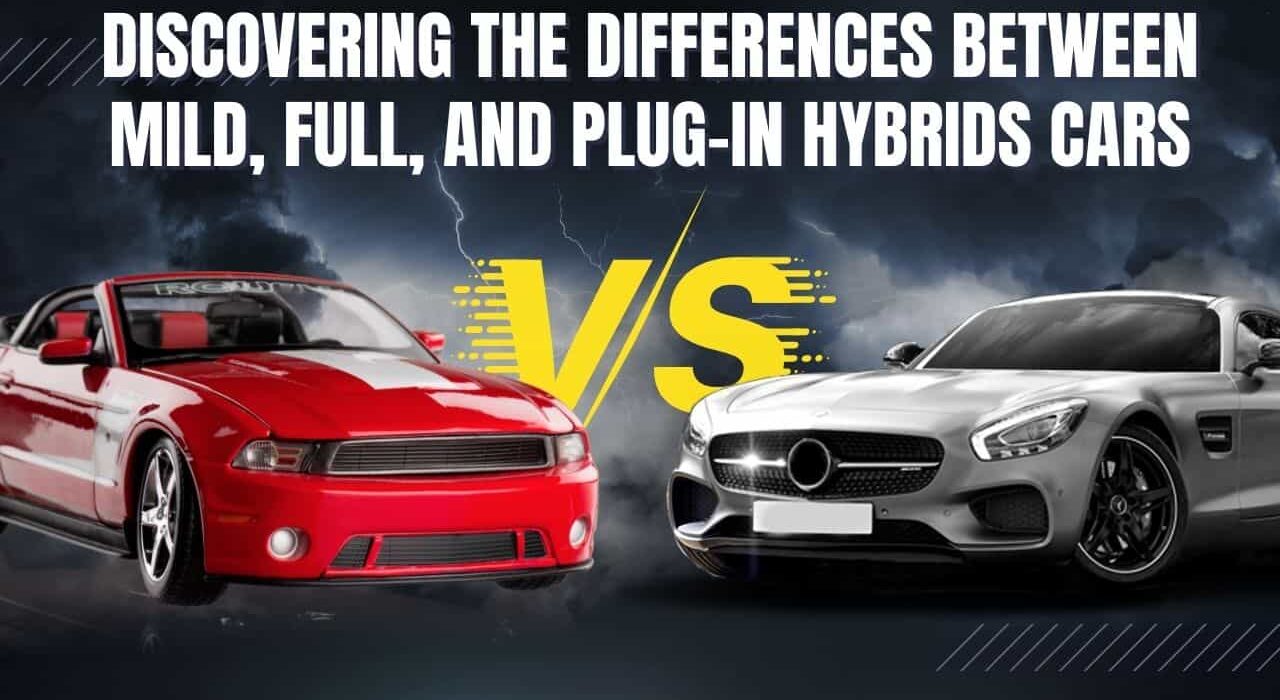As is already clear, the automobile industry is evolving continuously and quickly, with the electron unquestionably playing a leading role in this transformation. In reality, we are in the midst of the “electric shift,” to put autonomous driving and infotainment aside for a moment. At this point, almost all automakers offer fully or partially electrified vehicles.
But, if there aren’t any significant changes in how completely electric cars operate, partially electrified vehicles, often known as hybrids, are broken down into three groups: mild hybrids, full hybrids, and plug-in hybrids.
We are fully aware that these terms can still be very confusing for non-experts, and it is for this reason that we have chosen to write this brief tutorial. The three technologies and the features that set them apart from one another are succinctly described in this article.
But first, a presumption must be established. To create this material, we worked with Hyundai, a forward-thinking firm that is highly conscientious about electrifying their whole lineup. Be mindful that we are likely discussing the brand with the broadest selection of electrified vehicles, including hydrogen and mild, full, plug-in, and 100% electric models.
The Differences Between Mild, Full, and Plug-in Hybrids Cars
All three categories of hybrid vehicles, mild, full, and plug-in hybrid cars are vehicles that use both an electric motor and a gasoline engine, although they operate differently.
Mild Hybrid: To maximise fuel efficiency, mild hybrids pair a modest electric motor with a gasoline engine. The gasoline engine can be helped by the electric motor during acceleration or other high-power demands, but it cannot drive the car on its own. A mild hybrid vehicle has a small battery that is often recharged by regenerative braking, which transforms kinetic energy into electricity.
Full Hybrid: Compared to mild hybrids, full hybrids have larger electric motors and batteries, allowing them to run at low speeds solely on electricity. In order to produce power when it is required, the gasoline engine cooperates with the electric motor. Regenerative braking is another option for full hybrids to replenish their batteries. The Toyota Prius is among the most well-known complete hybrid automobiles.
Plug-in Hybrid: Plug-in hybrids (PHEVs) may be charged using an external power source, such as a charging station, and have larger batteries than mild and full hybrids. This enables them to go for longer distances, usually 20 to 50 miles, on just electric power (32-80 km). As soon as the battery is empty, the gasoline engine starts. Regenerative braking is another method PHEVs use to replenish their batteries. The Chevrolet Volt and the Mitsubishi Outlander PHEV are two examples of PHEVs.
In conclusion, plug-in hybrids are the most electrified and can travel farther on electric power alone than mild hybrids, which are the least electrified and mostly rely on the gasoline engine. Between mild and plug-in hybrids, full hybrids have a larger battery and electric motor. However, they are not as huge as plug-in hybrids.
MILD HYBRID
Without further ado, I’d say let’s begin with our justification. Let’s go through the electrical system in order of increasing importance, starting with mild hybrid vehicles. Mild Hybrid Electric Vehicles, often known as MHEVs, are currently the most prevalent category, but they are also likely the most contentious and the subject of the greatest scepticism. So, don’t be alarmed; it’s much easier than it seems.
The fundamental idea is that the cars we are talking about can NEVER be propelled completely by an electric engine. These are actually endothermic vehicles that have a small electric motor and battery added along with the appropriate electrical system, which can be 12V, 24V, or 48V depending on the system’s power (in the case of Hyundai, we’re always talking about 48V). The maximum output of this electric motor is between 10 and 12 kW, with a torque of about 150 Nm.
But when does the electric motor start running? In all circumstances where the internal combustion engine requires assistance to minimise effort and maximise fuel consumption and emissions, the electron propulsion is always triggered in conjunction with it. In particular, we’re referring about the moment the automobile starts, when you’re moving, when you need a bit more cue, like when you need to pass someone.
Only when the accelerator is disengaged and the car is moving by inertia, or during the sailing stages, does the electrical system operate on its own.
The electrical system takes over to keep all the systems functioning and to reduce the lag caused by the internal combustion engine’s ignition when we start pressing the accelerator again, whereas in an endothermic car the engine would remain on while keeping the engine brake function.
In essence, the electric motor achieves performance and consumption optimization in all the stages where the internal combustion engine performs less well.
In contrast to the traditional automobile battery, which is typically small and has a capacity of just about 0.5 kWh, this electric propulsion system is plainly supplemented by an additional battery. During acceleration and braking, this battery is always and only ever automatically recharged. As a result, the automobile cannot be connected to any columns or outlets for charging.
What are a mild hybrid system’s major benefits? The versatility of this technology is undoubtedly one of its benefits. These parts can be easily added to an existing platform, and the weight of the cars in which they are utilised is not much increased.
But we also need to remember that reducing consumption and emissions is just as significant. All of this comes at a modest cost, especially when Full-Hybrid alternatives and additional Plug-in Hybrids are taken into account. For example, the Hyundai i20, i30 (here is our road test), Bayon, Kona, and Tucson are all Mild Hybrid models that have 48V hybrid powertrains and cost somewhat more than endothermic counterparts.

What is Money Control App? How Does Moneycontrol App Work? Know All About It In 2024
Moneycontrol app is a new and innovative program that will help you keep track of all your money-making and income earning. With this amazing application, you are not limited to your finances and bills, you can also track your bandwidth

What is Udaan App? Complete Knowledge Of Udaan App in 2024
Udaan App is an innovative mobile app that enables retailers to monitor their sales, manages their inventory and access vital data regarding their business through their mobile devices. This enables business owners to use innovative apps for their businesses such

What is Projector Mobile And How It works? Best Projector Mobile in 2024
What are Projector Mobile and how it works? In its simplest form, a mobile projector is a small handheld projector that you can take with you. You can simply walk up to the display to watch a movie or presentation.
FULL HYBRID
And in this case, we’re discussing solutions for HEVs, or hybrid electric vehicles. These are now offered by a wide variety of manufacturers, albeit in far fewer quantities than the Mild Hybrid variants. This is due to the fact that building a Complete Hybrid system is more difficult, expensive, and necessitates the usage of a platform that has been specifically created or otherwise modified to host it.
There are five Complete Hybrid platforms available right now, but for the sake of this article, we’re not interested in learning what makes them unique. We’re curious to know how Full Hybrid technology operates in this case.
So, the Full Hybrid automobiles’ key distinction from Mild Hybrid versions is that they have a limited electric-only range of a few kilometres. This is due to the fact that the available electric motor—which is roughly 30–40 kW in power and is also directly attached to the wheels—is plainly more powerful. Additionally, the battery in the Full Hybrid vehicles is bigger, up to 1.5 kWh, as it must obviously enable the car to go 3–4 km on electric power alone.
Nonetheless, starting with charging mode, there are differences amongst Mild Hybrid systems. In this instance as well, the automobile cannot be connected to a home outlet or a column to recharge the battery. Recharging happens when we brake, when we accelerate, but it also happens when the engine is running at full power.
At this point, the charging system is run using a small portion of the engine’s output power. The only exceptions are when the battery is exceptionally low; in those situations, the thermal recharges the battery regardless of the circumstances until it rises above a predetermined charge level.
In the case of so-called Full Hybrid hybrids, the electric motor replaces the internal combustion engine during the ignition and start-up phases, during low-speed manoeuvring, when more starting point is required, and in some circumstances, when running.
During a few hundred metres if acceleration is not rapid or when we are moving at a consistent pace and below a set limit, usually 90 to 100 km/h, this typically occurs when we restart from traffic lights. In these circumstances, if the battery is fully charged, it is possible to turn off the internal combustion engine and rely solely on the electric component for traction.
The benefits provided by this method primarily come in pairs, one as a result of the other. The first is in consumption, which may be greatly decreased with these Full Hybrid vehicles when operated properly. For instance, using a Hyundai Kona Full Hybrid, I was able to maintain averages pretty close to 30 km/l on my commute from home to work, which is respectable for a B-Suv.
The Hyundai Tucson that was used to create the material today greatly astonished me; an average of 18 km/liter over a mixed route is astonishing for a car that weighs approximately 1650 kg and offers this much inside room. The second benefit, which is provided by the emissions reduction, is then brought about by all of this and is noteworthy on other Full Hybrid vehicles like the Santa Fe.
The weight of this technology is undoubtedly more than that of non-hybrid variants, and its price is also greater than that of equivalent models powered by endothermic energy.
PLUG-IN HYBRID
The Plug-In Hybrid Technology, commonly known as PHEV, or Plug-in Hybrid Vehicle, brings us to a close. But the real question is, how can a hybrid automobile extend its electric range? The answer is straightforward: simply raise the battery’s capacity and the engine’s output power. As a result, we progress from the Full Hybrid models’ 1.5 kWh battery to the 9–10, and even 18 kWh of the Plug-In Hybrid versions.
By converting this data into numbers and kilometres, we can state that this type of vehicle has an electric-only range of up to 50–60 km. According to official data, the Tucson PHEV, for instance, can travel up to 62 kilometres on the mixed WLTP cycle, compared to 58 km for the Santa Fe, the other Hyundai plug-in model.
In addition to having a longer electric range than Full Hybrid versions, Plug-In models also have a different recharging system. Although there is still a chance to collect energy when braking, the actual charging is done by connecting them to a socket or the traditional columns, just as electric cars.
Similar to the Full-Hybrid, management software determines when to utilise the internal combustion engine alone, the internal combustion engine in combination with the electric motor, and the electric motor alone. Furthermore, it is nearly always feasible to manually choose between using the automatic hybrid configuration—as was just mentioned—and forcing the use of the electric motor alone.
The primary benefit of this technology is the ability to travel significantly farther distances only on an electric engine. It should go without saying that the battery must always be as fully charged for this type of car to be used properly. In order to always have a full battery in the morning and to travel the majority of your distance without using fuel, charging them every evening is great. With the added benefit of being able to use the heat engine on longer trips when stopping three to four times to recharge could be problematic.
The cost and weight of this technology are its drawbacks. Although the price of plug-in vehicles is still relatively high, it can be lowered with the help of government incentives. On the other hand, because a larger battery and the associated charging mechanism must be integrated, the weight is even higher than that of the Full Hybrids. When we solely use the heat engine, the effect is higher consumption.
SUMMARY
To sum up: Mild hybrid vehicles have a small battery, around half a kWh, that recharges during braking and deceleration. The electric motor assists the internal combustion engine (ICE) in doing the most expensive tasks, but they are unable to run entirely on electricity. They are now the most popular, the least expensive, and have the least effect on fuel consumption and emissions.
Vehicles with a Full Hybrid system have a battery that is slightly larger (on average 1.5 kWh), recharged when braking, decelerating, and driving during periods when the internal combustion engine is operating at optimal efficiency, and they may go a short distance on electric power alone. They have a positive influence on lowering consumption and pollutants, but their cost is undoubtedly higher than that of mild hybrids because they require more expensive larger batteries and more potent electric motors.
The Plug-In hybrids, which have even larger batteries—up to 18 kWh—are partially recharged using the same technique as the Full Hybrids, but also and most importantly by connecting to the power grid. They have an electric range of up to 50 km and, when operated properly, can achieve emissions and consumption levels that are extremely near to those of electric vehicles.
However, they are very heavy and use more energy when operating in thermal mode than non-electric alternatives. They are also more expensive than the latter, although the price can be reduced by utilising the different incentives that are offered.







